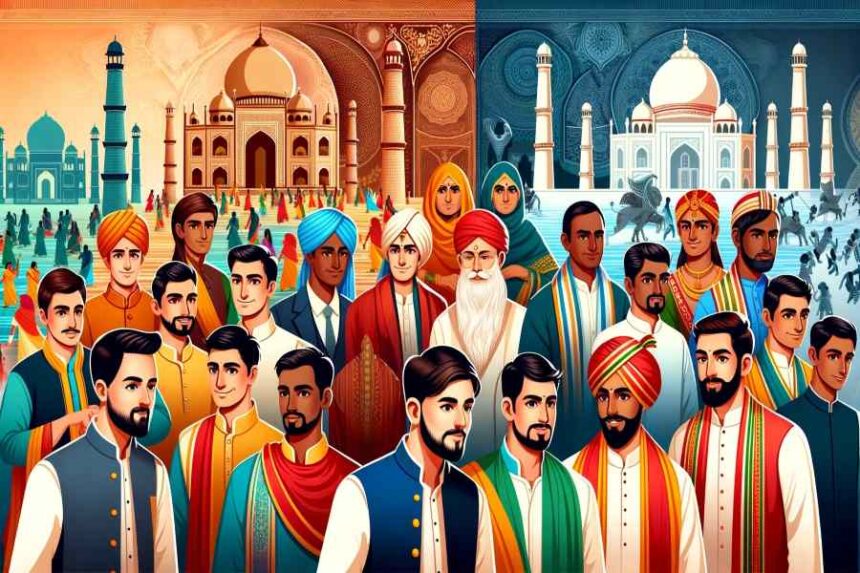India is a land of incredible diversity, with each region showcasing its unique culture, language, cuisine, and traditions. Among the many regional distinctions, the differences and similarities between North Indians and South Indians stand out prominently. While both groups share a common national identity, their cultural expressions, social norms, and lifestyles often contrast vividly. Understanding these differences enriches our knowledge of India’s rich tapestry and fosters greater appreciation and respect for its people. In this article, we delve into the multifaceted aspects of North Indians vs South Indians, exploring everything from linguistic variations to culinary delights and examining how historical influences have shaped their distinct identities.
Cultural and Linguistic Differences
North India and South India are distinct in their cultural and linguistic landscapes. The languages spoken in the North, such as Hindi, Punjabi, and Urdu, belong to the Indo-Aryan family. At the same time, the South is home to Dravidian languages like Tamil, Telugu, Kannada, and Malayalam. These linguistic differences are deeply rooted in history and have shaped each region’s literary and artistic expressions.
Culturally, North Indians and South Indians celebrate a variety of festivals that reflect their unique traditions and religious practices. In the North, festivals like Diwali, Holi, and Karva Chauth are enthusiastically celebrated. Conversely, South Indians celebrate Pongal, Onam, and Ugadi equally enthusiastically. These festivals highlight regional diversity and demonstrate the unity in India’s cultural mosaic.
Traditional attire also varies significantly. North Indian women typically wear sarees and salwar kameez, while men don kurta-pajamas and sherwanis. In contrast, South Indian women often wear silk sarees with intricate designs, and men wear dhotis and lungis. These clothing styles reflect the climate and lifestyle and hold cultural significance.
Marriage customs differ as well. North Indian weddings are known for their elaborate ceremonies and rituals, often lasting several days. South Indian weddings, although equally grand, follow different customs and traditions. For instance, the Tamil Brahmin wedding ritual of ‘Kashi Yatra’ and the ‘Mangalsutra’ tying ceremony in Kannada weddings are unique to the South.
The architectural styles in both regions reflect their historical and cultural evolution. North India boasts majestic Mughal architecture in monuments like the Taj Mahal and Red Fort. In contrast, South India is renowned for its Dravidian temple architecture, with examples like the Brihadeeswarar Temple and Meenakshi Temple showcasing intricate carvings and towering gopurams.
Historical and Political Contexts: North Indians vs South Indians
North India: A Historical Overview
North India has been a melting pot of cultures and civilizations throughout history. The region has witnessed the rise and fall of numerous empires and dynasties, each leaving a profound impact on its cultural and political landscape.
The Indo-Aryan migration around 1500 BCE brought significant changes, introducing the Vedic culture that laid the foundation for Hinduism. This era saw the composition of the Vedas, the oldest sacred texts of Hinduism. The region also experienced the rise of the Maurya and Gupta Empires, often regarded as the golden age of Indian culture, science, and administration.
The medieval period marked the arrival of Islamic rulers, most notably the Delhi Sultanate and the Mughal Empire. The Mughal era, starting in the early 16th century, is particularly significant for its contributions to art, architecture, and administration. Majestic monuments like the Taj Mahal, Red Fort, and Fatehpur Sikri stand testament to this period. The Mughal influence also led to the synthesis of Indo-Islamic culture, which has had a lasting impact on North Indian society.
The British colonial period brought significant political and social changes. The British East India Company gradually took control in the 18th century, leading to direct British rule after the Revolt of 1857. We established modern educational institutions, railways, and a centralized administration during this period. However, it also led to widespread economic exploitation and social unrest.
South India: Preserving Ancient Traditions
South India has maintained a more insular historical development, preserving its Dravidian culture and traditions. The region was home to powerful dynasties like the Cholas, Cheras, and Pandyas, who ruled extensive territories and contributed significantly to art, literature, and temple architecture.
The Chola dynasty, in particular, is renowned for its maritime expeditions, which extended South Indian influence to Southeast Asia. The grand temples of Tamil Nadu, such as the Brihadeeswarar Temple in Thanjavur, exemplify the architectural and artistic achievements of this era.
South India largely escaped the Mughal Empire’s direct rule, allowing it to preserve its distinct cultural identity. The Vijayanagara Empire flourished in the 14th to 17th centuries, was a bulwark against northern invasions, and fostered a renaissance in art and culture. The ruins of Hampi, the empire’s capital, are a UNESCO World Heritage site and a testament to its glory.
Cuisine and Culinary Traditions: North Indians vs South Indians
- North Indian Cuisine North Indian cuisine is characterized by its rich and creamy gravies, extensive use of dairy products, and various breads. Popular dishes include butter chicken, dal makhani, and paneer tikka. The staple diet in the North revolves around wheat-based products like roti, naan, and paratha.
- South Indian Cuisine In contrast, South Indian cuisine is predominantly rice-based. Dishes such as dosa, idli, sambar, and rasam are staples. Coconut and spices are extensively used, adding distinct flavors to the food. Each state in the South offers unique specialties, such as Hyderabadi biryani, Tamil Nadu’s Chettinad cuisine, and Kerala’s seafood dishes.
- Influence of Climate and Geography The climatic and geographical differences between the regions influence their culinary practices. North India experiences a more extreme climate, reflected in its hearty and rich dishes designed to provide warmth during colder months. South India’s tropical climate produces lighter, spicier, easily digestible, and cool dishes.
- Festivals and Food Festivals in both regions are marked by particular foods. For instance, North Indian Holi is synonymous with sweets like gujiya and thandai, while South Indian Pongal features the eponymous sweet dish made from rice and lentils. These festival foods symbolize the harvest and celebrate the bounty of the land.
Conclusion
The differences between North and South Indians testify to India’s incredible diversity. While their languages, cultures, cuisines, and social norms may vary, both regions contribute to India’s rich and multifaceted heritage. Understanding these differences helps foster greater appreciation and unity among India’s people, showcasing the strength found in diversity.
FAQs
Q: What languages are spoken by North Indians and South Indians?
A: North Indians primarily speak Indo-Aryan languages like Hindi, Punjabi, and Urdu, while South Indians speak Dravidian languages like Tamil, Telugu, Kannada, and Malayalam.
Q: How do North Indian and South Indian cuisines differ?
A: North Indian cuisine features rich and creamy gravies with a focus on wheat-based dishes like roti and naan. South Indian cuisine is predominantly rice-based, with dishes like dosa, idli, and sambar being staples.
Q: How do family structures differ between North and South India?
A: North India generally follows a patriarchal family structure with common joint families. South India has both patriarchal and matriarchal systems, with a strong emphasis on education and professional success.




